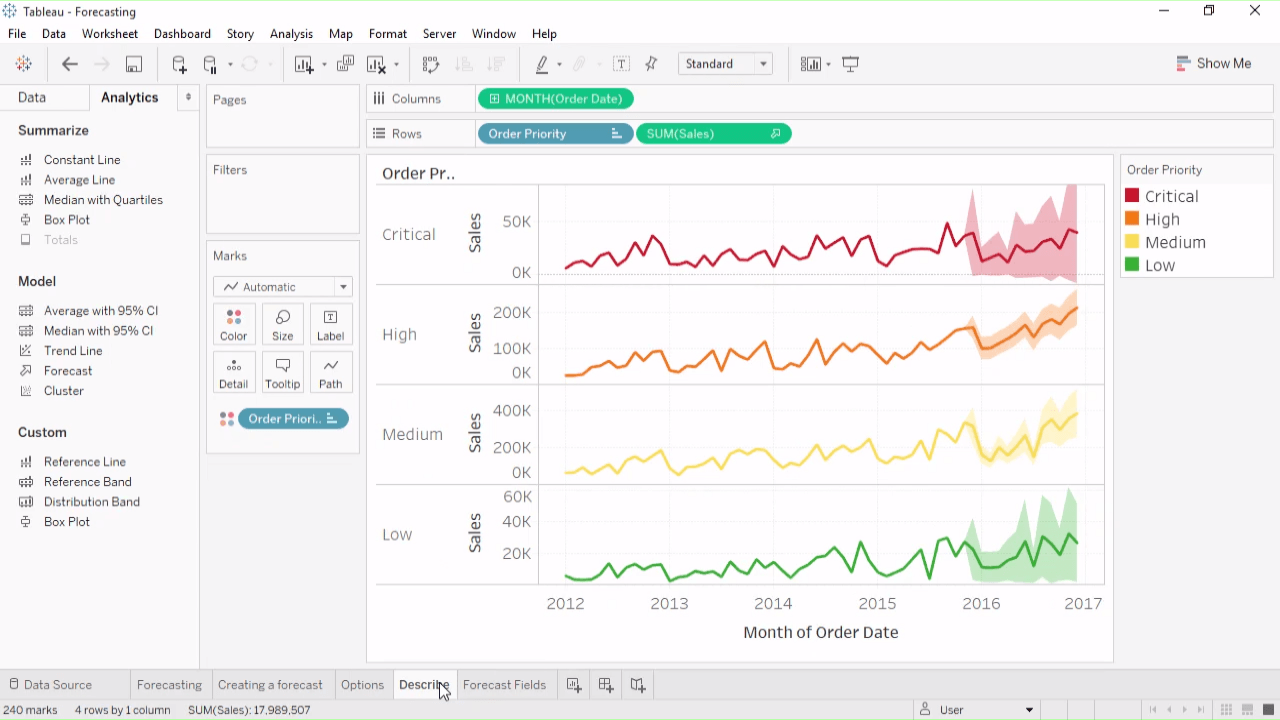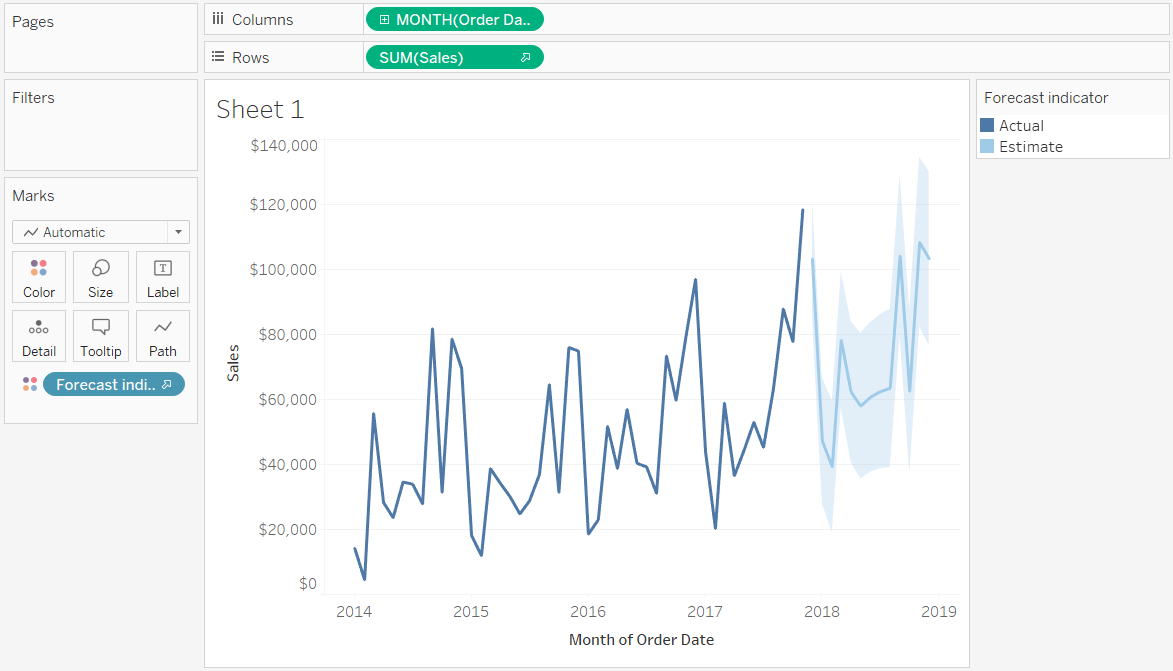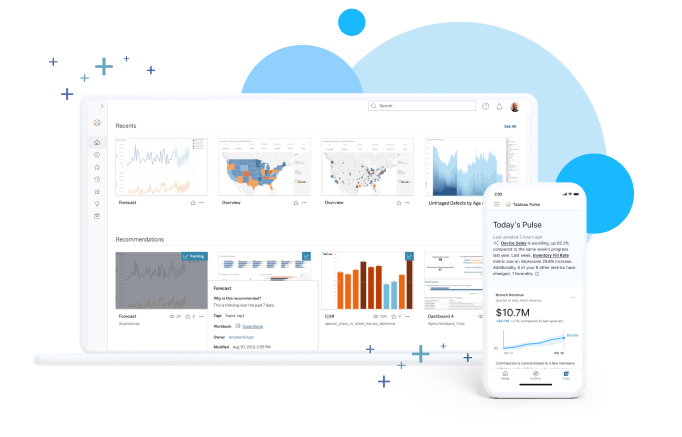Time Series Forecasting: Definition, Applications, and Examples
Try Tableau for FreeTime series forecasting occurs when you make scientific predictions based on historical time stamped data. It involves building models through historical analysis and using them to make observations and drive future strategic decision-making. An important distinction in forecasting is that at the time of the work, the future outcome is completely unavailable and can only be estimated through careful analysis and evidence-based priors.
What is time series forecasting?

Time series forecasting is the process of analyzing time series data using statistics and modeling to make predictions and inform strategic decision-making. It’s not always an exact prediction, and likelihood of forecasts can vary wildly—especially when dealing with the commonly fluctuating variables in time series data as well as factors outside our control. However, forecasting insight about which outcomes are more likely—or less likely—to occur than other potential outcomes. Often, the more comprehensive the data we have, the more accurate the forecasts can be.
While forecasting and “prediction” generally mean the same thing, there is a notable distinction. In some industries, forecasting might refer to data at a specific future point in time, while prediction refers to future data in general. Series forecasting is often used in conjunction with time series analysis. Time series analysis involves developing models to gain an understanding of the data to understand the underlying causes. Analysis can provide the “why” behind the outcomes you are seeing. Forecasting then takes the next step of what to do with that knowledge and the predictable extrapolations of what might happen in the future.
Applications of time series forecasting
Forecasting has a range of applications in various industries. It has tons of practical applications including: weather forecasting, climate forecasting, economic forecasting, healthcare forecasting engineering forecasting, finance forecasting, retail forecasting, business forecasting, environmental studies forecasting, social studies forecasting, and more. Basically anyone who has consistent historical data can analyze that data with time series analysis methods and then model, forecasting, and predict. For some industries, the entire point of time series analysis is to facilitate forecasting. Some technologies, such as augmented analytics, can even automatically select forecasting from among other statistical algorithms if it offers the most certainty.
When time series forecasting should be used
Naturally, there are limitations when dealing with the unpredictable and the unknown. Time series forecasting isn’t infallible and isn’t appropriate or useful for all situations. Because there really is no explicit set of rules for when you should or should not use forecasting, it is up to analysts and data teams to know the limitations of analysis and what their models can support. Not every model will fit every data set or answer every question. Data teams should use time series forecasting when they understand the business question and have the appropriate data and forecasting capabilities to answer that question. Good forecasting works with clean, time stamped data and can identify the genuine trends and patterns in historical data. Analysts can tell the difference between random fluctuations or outliers, and can separate genuine insights from seasonal variations. Time series analysis shows how data changes over time, and good forecasting can identify the direction in which the data is changing.
Time series forecasting considerations

The first thing to consider is the amount of data at hand—the more points of observation you have, the better your understanding. This is a constant across all types of analysis, and time series analysis forecasting is no exception. However, forecasting relies heavily on the amount of data, possibly even more so than other analyses. It builds directly off of past and current data. The less data you have to extrapolate, the less accurate your forecasting will be.
Time horizons
The time frame of your forecast also matters. This is known as a time horizon—a fixed point in time where a process (like the forecast) ends. It’s much easier to forecast a shorter time horizon with fewer variables than it is a longer time horizon. The further out you go, the more unpredictable the variables will be. Alternatively, having less data can sometimes still work with forecasting if you adjust your time horizons. If you’re lacking long-term recorded data but you have an extensive amount of short-term data, you can create short-term forecasts.
Dynamic and static states
The state of your forecasting and data makes a difference as to when you want to use it. Will the forecast be dynamic or static? If the forecast is static, it is set in stone once it is made, so make sure your data is adequate for a forecast. However, dynamic forecasts can be constantly updated with new information as it comes in. This means you can have less data at the time the forecast is made, and then get more accurate predictions as data is added.
Data quality
As always with analysis, the best analysis is only useful if the data is of a useable quality. Data that is dirty, poorly processed, overly processed, or isn’t properly collected can significantly skew results and create wildly inaccurate forecasts. The typical guidelines for data quality apply here:
- Make sure data is complete,
- is not duplicated or redundant,
- was collected in a timely and consistent manner,
- is in a standard and valid format,
- is accurate for what it is measuring,
- and is uniform across sets.
When dealing with time series analysis, it is even more important that the data was collected at consistent intervals over the period of time being tracked. This helps account for trends in the data, cyclic behavior, and seasonality. It also can help identify if an outlier is truly an outlier or if it is part of a larger cycle. Gaps in the data can hide cycles or seasonal variation, skewing the forecast as a result.
Examples of time series forecasting
Here are several examples from a range of industries to make the notions of time series analysis and forecasting more concrete:
- Forecasting the closing price of a stock each day.
- Forecasting product sales in units sold each day for a store.
- Forecasting unemployment for a state each quarter.
- Forecasting the average price of gasoline each day.
Things that are random will never be forecast accurately, no matter how much data we collect or how consistently. For example: we can observe data every week for every lottery winner, but we can never forecast who will win next. Ultimately, it is up to your data and your time series data analysis as to when you should use forecasting, because forecasting varies widely due to various factors. Use your judgment and know your data. Keep this list of considerations in mind to always have an idea of how successful forecasting will be.
